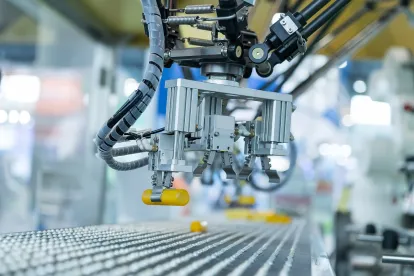New law to tackle the shortage of semiconductor chips will direct $280 billion to research and production of semiconductors in the United States. While the dramatic increase in federal grants, loans, and other programs under the Creating Helpful Incentives to Produce Semiconductors (CHIPS) Act of 2022 promises much, manufacturers and other employers should consider carefully how to participate.
The Basics
Found in everything from household appliances to cars and fighter jets, semiconductors play a vital role in the global economy. Due to the country’s dependence on foreign semiconductors, semiconductor shortages in recent years have greatly affected manufacturers in the United States, including in the automotive industry.
The CHIPS Act seeks to increase domestic production of semiconductors and reduce dependence on imported chips through two key methods: (1) government funding and (2) tax credits.
Government Funding for Manufacturers
The statute earmarks $52.7 billion in federal grants, loans, and other programs for the fabrication, production, testing, assembly, and packaging of semiconductors within the United States. Eligible recipients must produce semiconductors or manufacture semiconductor materials and equipment. Eligible manufacturers will compete for funding through applications to the Department of Commerce.
Funding documents providing specific application guidance are expected to be released by early February 2023. The Department of Commerce has signaled that it will give preference to manufacturers who secure state or local incentives. According to the Department’s press release, successful applicants will commit to maximizing regional and local competitiveness, investing in the surrounding community, and prioritizing broad economic gains, rather than funneling funds exclusively to corporate expenditures.
The Department also has indicated that it will prioritize projects that proactively work to ensure small businesses, rural businesses, and minority-, veteran-, and women-owned businesses benefit from opportunities generated by the CHIPS Act.
International entities can apply for funding, but the Act prohibits “foreign entities of concern” from receiving any funding or assistance. Entities of concern are those “owned by, controlled by, or subject to the jurisdiction or direction” of a foreign country listed in 10 U.S.C. § 2533c, including China, Russia, Iran, and North Korea.
In fact, the Act includes a “guardrail” or “clawback” measure to ensure recipients avoid foreign entities of concern altogether. For example, the Department can claw back the full amount of an award if a recipient raises national security concerns by knowingly engaging in a “joint research or technology licensing effort” with a covered nation.
Tax Credits for Manufacturers
The CHIPS Act adds the Advanced Manufacturing Investment Credit (AMTC) as Section 48D of the Internal Revenue Code. The AMTC offers manufacturers a 25 percent credit for the construction of semiconductor manufacturing facilities (or facilities that produce manufacturing equipment), which includes any tangible property essential to the facilities, excepting offices and administrative buildings. To qualify, construction of the manufacturing facilities must begin by January 1, 2027.
To benefit from the tax credit, manufacturers must avoid entanglement with “foreign countries of concern.” The expansion of semiconductor manufacturing in China, for example, will make an employer ineligible for the tax credit. Additionally, like the funding clawback provisions, the Department of Commerce can recover the credit if the transgression cannot be cured within 45 days after notice from the Treasury Department.
Compliance
Recipients of CHIPS Act funding and tax credit will have to comply with federal requirements. Although more guidance are expected, the Act provides key considerations for manufacturers hoping to benefit from the increase in spending.
Certain to garner the attention of manufacturers seeking CHIPS Act funding are the clawback provisions. Additionally, CHIPS Act-funded construction projects must comply with Davis-Bacon prevailing wage requirements. This means construction efforts must pay contractors and subcontractors no less than locally prevailing wages, as determined by the Department of Labor.
In addition, recipients must comply with the Act’s prohibition on the use of funds on stock buybacks or dividend payments to shareholders.
Entities seeking CHIPS Act funding also are likely to find themselves subject to agency or Congressional reporting requirements with respect to workplace (demographic-focused) data similar to those that banks and other financial institutions are currently facing as the Biden Administration continues to press its social justice, workforce transparency, and equity initiatives. Manufacturers new to the role of federal contractor will need to act now to ensure their HR and information systems and organizational structures will facilitate the required reporting accurately, as well as reflect the manufacturer’s operating imperatives that help to explain their workforce (demographic-focused) data in such areas as pay equity, promotions, and hiring.
Staffing Shortages, Workforce Development
With the influx of federal funds, many manufacturers will need to hire to meet the increased market demand. Many semiconductor manufacturers reportedly are calling for immigration reform to attract qualified workers from abroad as the Act is expected to exacerbate existing workforce shortages.
To ease the worker shortage, the Act provides $200 million to the National Science Foundation to formulate a shared curriculum and infrastructure to graduate qualified candidates. The Act contemplates shared training and regional partnerships between educational institutes and employers. Some reports estimate that semiconductor manufacturers will need to staff 300,000 newly created production jobs to fulfill the Act’s policy goal of sustained domestic production. Such a staffing goal could take years. In the meantime, however, many manufacturers will have to compete for skilled STEM professionals and international hires.





 />i
/>i

